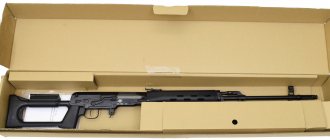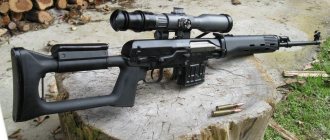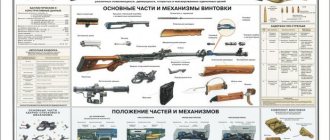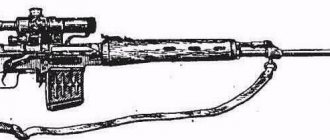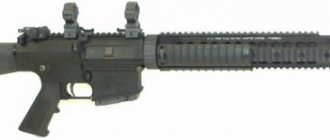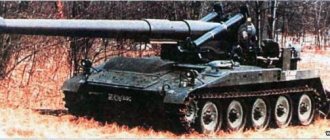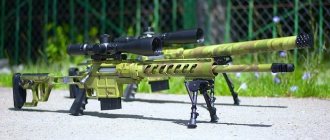It is under this name that the Soviet SVD, which has been serving faithfully since 1963, is known to all snipers.
It is obsolete and needs to be replaced.
Comparison of the length of the Dragunov and Chukavin rifles.
Image source, Military News website One of the initiative developments of Russian gunsmiths, which with a high degree of probability claims to replace a veteran, is the semi-automatic microwave rifle, created at the Kalashnikov concern under the leadership of Andrei Chukavin. The weapon was created as part of the Ratnik project, conducted by the Russian Defense Ministry.
Problems to be solved
This weapon is primarily intended for use in combined arms units by highly qualified shooters.
In English-speaking countries they are called designated marksman, which loosely translated means “infantry sniper.”
Microwave.
Image source, YouTube website of the Kalashnikov concern The rifle is designed to guarantee the destruction of a potential enemy at medium and short distances during combined arms combat. The overall dimensions of the new weapon allow the sniper to use only it in battle. This increases mobility.
But, when creating it, the design team focused on other tasks, to create a universal platform for working on the entire line of promising small arms of the concern.
Objective Individual Combat Weapon
Objective Individual Combat Weapon
or
OICW
was a next-generation service rifle competition that was under development as part of the US Army's OICW program; the program was ultimately terminated without moving the weapon out of the prototype phase. The acronym OICW is often used to refer to the entire weapons program.
It was started after the advent of the Advanced Combat Rifle (or ACR) in the 1980s. Like the ACR program, it was largely a failure in terms of achieving specific program goals (such as replacing the M16) and cost millions of dollars, but led to many innovative weapons and weapons concepts, as well as offshoot programs of its own.
Design features
Chukavin adopted the SVD as a basis, which was subjected to significant modernization. But this direction turned out to be a dead end.
Using this path, it turned out to be impossible to achieve a noticeable reduction in dispersion, use modern optical systems, or radically improve ergonomics.
Options for microwave rifles created for various ammunition (from top to bottom): chambered for NATO, 7.62×51 NATO;
chambered for standard Russian cartridge, 7.62x54R; chambered for the large-caliber Magnum cartridge, 8.6×70 (.338). image source, Military News website During the development process, the technical specifications included the concept of universality in the types of ammunition used. The choice was made in favor of the most popular small arms on the world market:
- 7.62*54R – basic model for an SVD magazine with 10 rounds (can be changed to 20 or 15);
- 7.62*51 NATO(.308Win) – Winchester standard.
The most popular rifle ammunition in the world. Implemented in the rifle model SHF-308. Design features are in the magazine receiver. Capacity is similar to the above options
- 338 LM (8.6*70) chambered for the Magnum cartridge - a sample rifle, SHF-8.6, received an enlarged receiver, a longer barrel, and acquired a muzzle brake. The bolt group has been adapted for this cartridge. The length has increased to 1015 mm.
Microwave rifle with body kit and silencer.
Please note: How to replace the air valve in the Kral Puncher Maxi 3 PCP rifle.
It is clearly visible that you can operate the shutter with your left hand. Image source, Interfax website
The latest model has maximum shooting accuracy, thanks to an elongated cartridge and a longer barrel.
The promising rifle had to function successfully with both low-pulse cartridges (this is the basis for the development of promising assault rifles), classic Russian rifle cartridges, and large caliber. The first two ammunition could be implemented in any of the existing classical designs, but for a large caliber, radically different solutions were required.
Chukavina rifle chambered for 7.62*54R ammunition at the exhibition stand. Image source, Bastion website
Chukavin's group was entrusted with the work of creating a new weapon using the existing classical design. The basis was taken from the fire monitor implemented by Nikonov in the model of the AN-94 assault rifle. Here the firing unit moves relative to the stationary carriage. And they supplemented it with a curtain scheme proposed in the Dragunov machine gun, created for the Modern competition.
Microwave. The design of the butt is clearly visible. Image source, Bastion website
The rifle received upper rails (classic solution, lower ones). This made it possible to significantly relieve the lower part and make it from aluminum alloys or composites. This solution significantly lightens the rifle.
In the process of developing a new design model, the following basic tasks were comprehensively solved:
- unified individual design elements with those used in other types of weapons of the concern;
- adhered to the principle of modularity;
- were able to implement the multi-caliber requirement;
- created an architecture that ensures the rapid transfer of a rifle from the classic version of the layout to the bullpup version.
For those who don’t know, this is a layout with the trigger positioned in front of the magazine and trigger.
The President of Russia is testing a microwave rifle (photo taken at Army 2017). Image source: wikipedia.org
Such a conversion is carried out with a minimum of design changes to the basic design of the rifle. It is enough to change only the lower component without changing the firing unit.
The rifle uses automation similar to SVD (short distance piston stroke).
Microwave sniper rifle at the firing line. Image source, YouTube website of the Kalashnikov concern
Alliant Techsystems / Heckler-Koch XM-29 OICW combined assault rifle (USA)
The XM-29 OICW (Objective Individual Combat Weapon) system in its modern form (2002).
Early OICW configurations (mid to late 1990s). 1 - combined 20mm grenade launcher and 5.56mm machine gun (modern version); 2 - 20 mm grenade launcher with attached 4.6mm HK PDW submachine gun; 3 - 20mm grenade launcher as a separate independent system.
View of the left side of the XM-29 OICW, showing the controls on the sighting unit.
Main components of the XM-29.
Ammunition for OICW - HE (High Explosive) and TP (Trainer, with a passive warhead) for the 20mm grenade launcher and KE - a standard 5.56mm cartridge.
Caliber
: 5.56mm NATO and 20x85mm
Automatic type
: gas operated, locking by turning the bolt (KE)
Length
: 890 mm
Barrel length
: 250 mm (KE);
460 mm (HE) Weight
: about 5.5 kg unloaded;
about 6.8 kg loaded Magazine
: 30 rounds of 5.56mm + 6 grenades 20 mm
The XM29 OICW (Objective Individual Combat Weapon) system is an attempt to dramatically increase the effectiveness of the infantryman’s individual weapons when the enemy uses personal protective equipment (helmets, body armor) and terrain conditions (shelters). The history of OICW dates back to 1986, when one of the leading military schools of the US Army, the Infantry School at Fort Benning, released a document called Small Arms System - 2000 (SAS-2000, Small Arms System 2000). This document, contrary to the then existing trends towards caseless cartridges (see Heckler-Koch G11) and cartridges with arrow-shaped striking elements (see Steyr ACR), argued that a significant increase in the effectiveness of small arms at this stage of development can only be achieved using weapons that fire compact high-explosive fragmentation (HE) shells and are equipped with advanced sighting systems. This system was supposed to provide accurate targeting of the target and detonation of the HE warhead directly at the target, even subject to some miss (to hit the target with fragments and high-explosive action). The main advantage of such a system was the independence of the effectiveness of action on a target from the firing range (the effectiveness of conventional bullets directly depends on the range to the target and falls as it increases). In addition, by detonating a warhead without a direct hit, the probability of hitting targets sharply increases by reducing the influence of aiming errors (a grenade that explodes 1 meter from the target will hit the target with fragments, and a bullet flying 10 cm from the target will not cause it the slightest harm). In 1989, the US Army TRADOC issued another advisory document called the Small Arms Master Plan (SAMP). This document also gave preference to systems that fire HE grenades with remote detonation at the target, and specified a family of “objective” (OBJECTIVE, designed to perform specific tasks) weapons as promising. This family was supposed to include three systems - Objective Individual Combat Weapon (OICW), Objective Crew Served Weapon (OCSW, 25mm automatic grenade launcher to replace mounted 40mm grenade launchers and 12.7mm machine guns) and Objective Personal Defense Weapon (OPDW, to replace pistols- machine guns and pistols). SAMP set the date of entry into service for “objective” weapons at 2000, which was obviously unrealistic. However, in light of the ineffectiveness of the ACR program (see Heckler-Koch G11 and Steyr ACR), research began on Objective Weapons programs, including OICW, in the early 1990s.
In 2000, it was decided that further development of the OICW program would be continued by a group of companies led by the American company Alliant Techsystems Inc (ATK). In addition to ATK, this group also includes Heckler-Koch (responsible for the development of the 20mm grenade launcher and 5.56mm machine gun), Brashear (responsible for the development of the sighting system) and a number of other companies.
At the beginning of 2003, successful test firing took place using 20mm HEAB (High Explosive, Air Burst) ammunition. In 2002, the US Army officially assigned the OICW system the designation XM29 (M29 after adoption). The start of production and entry into service was planned for 2008. According to the plans, each infantry squad of 9 people (Army, Marine Corps) should have had 4 M29 systems, which were supposed to replace the M16A2 complexes with M203 grenade launchers and M249 light machine guns that are currently in service. It was also assumed that the effectiveness of OICW compared to the M16/M203 complex would increase by as much as 5 times. It was planned that during mass production the cost of one sample would be no more than 10,000 US dollars, and the cost of one 20mm grenade would be no more than 25 US dollars (the current cost of the M16A2 rifle is about 600-700 US dollars).
Due to the decision on the need to increase the caliber of the grenade launcher part of the OICW system from 20 to 25 millimeters in 2004, it was decided to divide the development of a single OICW system into two initially independent systems - the 5.56mm modular rifle XM8 (OICW Increment 1) and the 25mm self-loading hand grenade launcher XM25 (OICW Increment 2). It is assumed that if the development of these systems is successful, then in the foreseeable future an attempt will be made to combine them again into a single XM29 OICW Increment 3 system. However, due to the failure of both programs, this never happened.
Technical description. The XM29 OICW is a modular design consisting of three main modules: the "KE" (Kinetic Energy) module, which is a slightly upgraded Heckler-Koch G36 rifle; The “HE” (High Explosive) module, which is a self-loading 20mm magazine-fed grenade launcher, installed on top of the “KE” module and using a trigger shared with the “KE” module for firing; And finally, the fire control module, which includes day/night television sights, a laser rangefinder and a ballistic computer, which automatically sets the aiming mark in the lens in accordance with the range to the target, and is also used for programming remote fuses of 20mm grenades.
The “KE” module, as mentioned above, is a slightly modified HK G36K assault rifle without a stock, which has a backup open sight. Firing modes - single, bursts of 2 shots and automatic fire. The “KE” module can be used separately from the other two as a regular shortened machine gun (more precisely, due to its characteristics - like a PDW or a submachine gun). As part of the system, the KE module is used as a melee weapon (the minimum range of use of 20mm grenades is about 50-100 meters) or to hit targets at which there is no need to fire expensive 20mm guarantors. The 5.56mm rifle is aimed through a single sighting unit. One of the features worth noting is the block of buttons located next to the trigger for controlling the fire control system. In 2002, the shortened assault rifle, part of the XM-29 system, received the designation XM-8, and it is quite possible that in the future it will be adopted by the US Army as a separate model.
The “NOT” module is a self-loading weapon built according to the bullpup design. The automation is based on a gas exhaust circuit. The rifled barrel is made of titanium. Two main types of ammunition can be used for firing - a high-explosive fragmentation grenade with a programmable fuse and a training grenade (with a passive warhead). The combat grenade has a programmable fuse with two main detonation modes - remote and impact. In remote mode, before firing, based on data from a laser range finder, the fuse is programmed to detonate in the air at a given range, which ensures that hidden targets are hit by shrapnel from above or from the side. In a contact detonation, the grenade warhead explodes when it directly hits the target. If the fire control system fails, only the second firing option is possible (contact detonation). For each grenade, the detonation mode can be set only once and cannot be changed. Determining the range for remote detonation is carried out by counting the revolutions made by the grenade in flight. Grenades are not intended for point-and-shoot shooting. The maximum flight time of a grenade at a distance of 1000 meters is 5.5 seconds. One of the features of the HEAB grenades, being tested in 2003, and planned for adoption along with the M29, is that they actually have 2 warheads, in the front and rear of the grenade, respectively, and an electronic programmable fuse is located between them. It is believed that such a scheme provides the best configuration of the fragmentation zone at the target. Obviously, if necessary, it is possible to create inexpensive 20mm cumulative armor-piercing grenades that can defeat lightly armored targets (armored personnel carriers, infantry fighting vehicles). Such grenades will cost much less (they do not need a programmable air-detonated fuse) and will significantly expand the combat capabilities of infantry. Since from a technological point of view such ammunition is very simple and does not require special research, their creation will most likely be carried out last. The “HE” module can be quickly removed from the “KE” module, but cannot be used by itself, since it uses the trigger and other controls located on the “KE” module. However, the option of creating a special stock with a pistol grip and fire controls for using a 20mm grenade launcher as a separate weapon, without a 5.56mm machine gun, has not been ruled out.
The fire control module includes a television sight with day and night channels and 6x magnification, a laser rangefinder and a ballistic microprocessor computer. The image from the television sight can be transmitted to the sight's built-in viewfinder, as well as to both the soldier's helmet-mounted display (created as part of the Land Warrior 21 program) and the commander's display (if appropriate equipment is available). The batteries to power the module are located in the butt of the weapon.
M203A2.
The M203 underbarrel grenade launcher was developed between 1967 and 1968 by the American corporation AAI under a contract with the US Army. The contract was based on the experience gained during the massive use of the 40-mm M79 grenade launcher by American troops in Vietnam. This experience showed the need and extreme usefulness of 40-mm grenade launchers, but also revealed the weaknesses of the M79, primarily the need for additional self-defense weapons for the grenade launcher. The first attempt to create a grenade launcher mounted under the standard M16A1 army rifle was made by Colt back in the mid-60s, however, experience in operating the 40-mm XM-148/Colt CG-4 grenade launcher showed its unreliability and unsafe handling, however, confirming the correctness of the concept itself underbarrel grenade launcher.
Author: prien_gunter from 2015-Dec-18, views: 2,251
The AG36 is an under-barrel 40-mm grenade launcher that operates on the High-Low System principle (while maintaining the firing range characteristics, the shooter feels less recoil when fired, compared to the classic M203 or GP-25 under-barrel grenade launchers).
The AG36 was designed primarily for mounting on the G36 assault rifle, built by Heckler & Koch of Oberndorf am Neckar.
The central idea of the program was to develop a rifle that would allow the attack of targets behind cover using aircraft ammunition. The ammunition was intended to be much smaller than existing grenades and grenade launchers, but large enough to be effective. The idea was reworked into a combination of a short assault rifle and a semi-automatic low-velocity cannon firing air-bursting ammunition. The OICW sought to harness advances in computer technology into a weapon that fired grenades automatically set to explode above or near targets hidden from view. The fragments from an exploding grenade could hit the target, whereas a conventional rifle could not.
The winners of the first competition for this design in the 1990s were ATK and firearms manufacturer Heckler & Koch with the XM29 OICW. They built numerous prototype rifles for the US Army in the late 1990s. These projects focused on the use of a programmable 20 mm rifle firing aircraft ammunition, alone or with other projectile weapons. The 20 mm launcher has been analyzed in various configurations, including a separate launcher, with a 5.56 mm weapon (based on the HK G36) or with an MP7 PDW.
By the early 2000s, the weapon's design was determined and it was classified as the XM29. The XM29 was based on the HK CAW (Close Combat Assault Weapon) (18.5×76mm caliber or 12 gauge unconventional). However, the weapon had serious problems: it did not meet weight or cost targets, and the 20mm High Explosive Air Burst (HEAB) did not prove lethal enough in testing. To complicate matters, the kinetic energy component had to be light and short in length. As a result, the 5.56×45mm NATO barrel was only 250 mm (9.8 in) long, which was too short to provide sufficient muzzle velocity to be effective as a standard infantry rifle. It was also too heavy and large for a soldier to operate effectively.
This led the Army to begin development of a new weapon and finally shelved the XM29 in 2004. The kinetic energy component was allocated to the XM8 rifle program, and the air burst component was developed into the XM25 air burst weapon. According to a presentation by Major Kevin Finch, Chief of Small Arms Division, Combat Development Command, US Army Infantry Center, the OICW program consisted of three main parts:
- Increment 1 (OICW 1) was a competition for an entire family of weapon systems similar to the XM8. The weapon system was intended to potentially replace the M4 carbine, M16 rifle, M249 light machine gun, and some M9 pistols. Other weapons companies argued that the goals of the OICW project had changed enough to prompt new competition. Potential contenders could include a weapon system based on the updated M16, the Steyr AUG, the FN SCAR, and possibly any other manufacturer that has met the Army's requirements to participate. It also states that the shotgun is being replaced by a modular shotgun system (XM26 LSS) installed on the OICW 1 winner. In July 2005, the Increment 1 portion was suspended for eight weeks, largely to accommodate input and needs from other services . On October 31, 2005, the OICW I program was canceled. The reason for the cancellation was stated as follows: "This action was taken to ensure that the Army reconsidered its small-caliber weapons priorities to incorporate new needs identified during Operation Enduring Freedom and Operation Iraqi Freedom." The government will also include studies examining current capability gaps during the said reassessment."
- The OICW Increment 2 was an autonomous explosive weapon (XM25). It is a self-contained launcher that uses larger 25mm ammunition and was intended to be used as a dedicated support weapon rather than a standalone combat weapon like previous models. In 2005, the gun underwent limited field trials and combat trials.
- Increment 3 OICW was XM29. The M203 was listed as being replaced by a combination of steps 2 and 3. The M249 was also to be partially replaced by the Lightweight MG (LMGA, now LSAT), which was listed as the successor to the M60 and M240.
Objective Individual Combat Weapon
| HK XM29 OICW | |
| OICW disassembled: from top to bottom - fire control module, HE module, KE module; bottom left to right - bayonet, rifle magazine with cartridge, belt and grenade launcher magazine with grenade | |
| Type | rifle-grenade launcher complex |
| A country | Germany USA |
| Production history | |
| Manufacturer | Alliant Techsystem |
| Characteristics | |
| Weight, kg | 5.2 (without ammo) 6.5 (loaded) |
| Length, mm | 890 |
| Barrel length, mm | 240 (KE module) 364 (HE module) |
| Cartridge | 5.56x45 mm NATO (KE module) 20x85 mm (HE module) |
| Caliber, mm | 5.56 (KE module) 20 (HE module) |
| Work principles | removal of powder gases, butterfly valve (KE-module) |
| Initial bullet speed, m/s | 750 |
| Maximum range, m | 500 |
| Type of ammunition | box magazine for 30 rounds (KE-module), magazine for 6 grenades (HE-module) |
| Aim | 6x television |
| Media files on Wikimedia Commons | |
(English O
bjective
I
ndividual
C
ombat
W
eapon -
an individual weapon designed to perform specific tasks
) is a promising American automatic grenade launcher system, designed in the 1990s by Alliant Techsystem.
In 2001, the complex was assigned the index XM29 OICW. In 2004, due to the insufficient effectiveness of the lethal effect of the 20-mm ABM (Air Burst Munition) grenade and the need to increase the caliber of the grenade launcher, the complex was divided into two independent systems - the 5.56-mm modular assault rifle XM8 (OICW Increment 1) and 25 -mm self-loading hand grenade launcher XM25 (OICW Increment 2), the development of which is currently frozen. The resumption of development of a single XM-29 complex is planned after testing independent subsystems and overcoming weight restrictions through the use of a number of improvements and the latest advances, including sensors and electronic components, composite materials, power supplies, ceramic barrels, wireless connectors and advanced digital technologies. At the same time, it is believed that a 25-mm controlled detonation grenade will make it possible to hit, in addition to openly located targets, also hidden targets, using folds of the relief and elements of protective structures and equipment.
NGSW Program: Weapons
The need to use in future small arms the separation of cartridges, the initial energy of which will significantly exceed not only the initial energy of intermediate ammunition of caliber 5.56x45 mm, 5.45x39 mm and 7.62x39 mm, but also rifle cartridges of caliber 7.62x51 mm and 7.62x54R , will require the use of design solutions in future small arms to reduce the impact of recoil on the shooter.
It should be noted that the US armed forces already had experience using automatic weapons chambered for powerful rifle cartridges. We are talking about an M14 automatic rifle chambered for the then new 7.62x51 mm caliber cartridge. In pursuit of the power of ammunition, the United States “missed” the appearance of the Soviet intermediate cartridge 7.62x39 mm, resulting in a powerful, but large and clumsy weapon.
The M14 rifle did not perform very well during US combat in Vietnam, especially in comparison with the Soviet AK-47 assault rifle that the Vietnamese had. Due to the large size and weight of the 7.62x51 mm cartridge, compared to the 7.62x39 mm cartridge, the magazine capacity (20 rounds versus 30 for the AK-47) and the carryable ammunition of an American soldier with an M14 were 1.5 times inferior to those of the Vietnamese soldier with AK-47.
Firing bursts from an M14 rifle with minimal acceptable accuracy is actually only possible from a bipod or rest, and at a range of about 100 meters. However, replacing the M4 with the M16 did not greatly improve the situation of American troops due to the behavior of small-caliber 5.56 mm bullets in dense jungles.
Let's return to the NGSW program. Of all the candidates mentioned above, General Dynamics-OTS Inc., AAI Corporation Textron Systems and Sig Sauer Inc. were allowed to create prototypes. FN America LLC and PCP Tactical, LLC are also mentioned in some sources, but their final status in the NGSW program is unclear.
As we remember, the recoil of the above-mentioned M4 rifle of 7.62x51 mm caliber did not allow us to ensure any acceptable accuracy and accuracy of burst fire. In the new weapons under the NGSW program, this problem should be solved despite the fact that the initial energy of the new 6.8 mm cartridge must exceed the initial energy of the 7.62x51 mm cartridge.
The proposed solutions include the use of standard silencers on promising rifles and machine guns, which reduce recoil by a third.
An additional benefit that an integrated suppressor would provide would be a reduction in the impact on a fighter's hearing, especially indoors. Of course, a soldier in a modern army must have hearing protection - active headphones, but in reality there are a huge number of situations where they either don’t exist or they fail. Also, the use of silencers on an ongoing basis will reduce the detection range of a fighter by muzzle flash and the sound of a shot.
Other ways to reduce recoil can include recoil momentum accumulation schemes, balanced automatics, various shock absorber designs and other design solutions, information about which may appear closer to the end of the NGSW program in 2022.
It can be assumed that the main mode of firing from 6.8 mm weapons will be a mode with a burst cut-off of 2 rounds, which is stated as desirable in the weapons being developed.
OICW concept
For the purposes of the program, it was assumed that the main weapon of destruction on the battlefield of the 21st century should be a self-loading grenade launcher module of 20 mm caliber with a wide range of smart ammunition. As part of the development of the project, a rifle module created on the basis of the HK G36 chambered for the 5.56x45 mm NATO cartridge was considered as an additional weapon for the personal self-defense of the infantryman. Both types of weapons were interfaced with an aiming module equipped with a six-fold optical sight, a night sight, a thermal imager and a laser rangefinder. Earlier designs used various configurations and settings.
Links
Submachine guns MP5 • MP7 • UMP Machine guns and automatic rifles • G36 • G41 • HK33 • HK416 • HK417 Machine guns HK11 • HK13 • HK21 • HK23 • HK121 • HK221 • HK MG4 Sniper rifles G28 • G3A3ZF-DMR • MSG90 • MSG90A1 • PSG1 • SR9 Civilian and sporting rifles HK41 • HK43 • SL6 • SL7 • SL8 Grenade launchers AG36 • AG-C/GLM (English)Russian • GMG • HK69 • M320 • XM-25 Prototypes Shotguns CAWS Miscellaneous P2A1 (English)Russian • P11 • 4.6×30 mm
